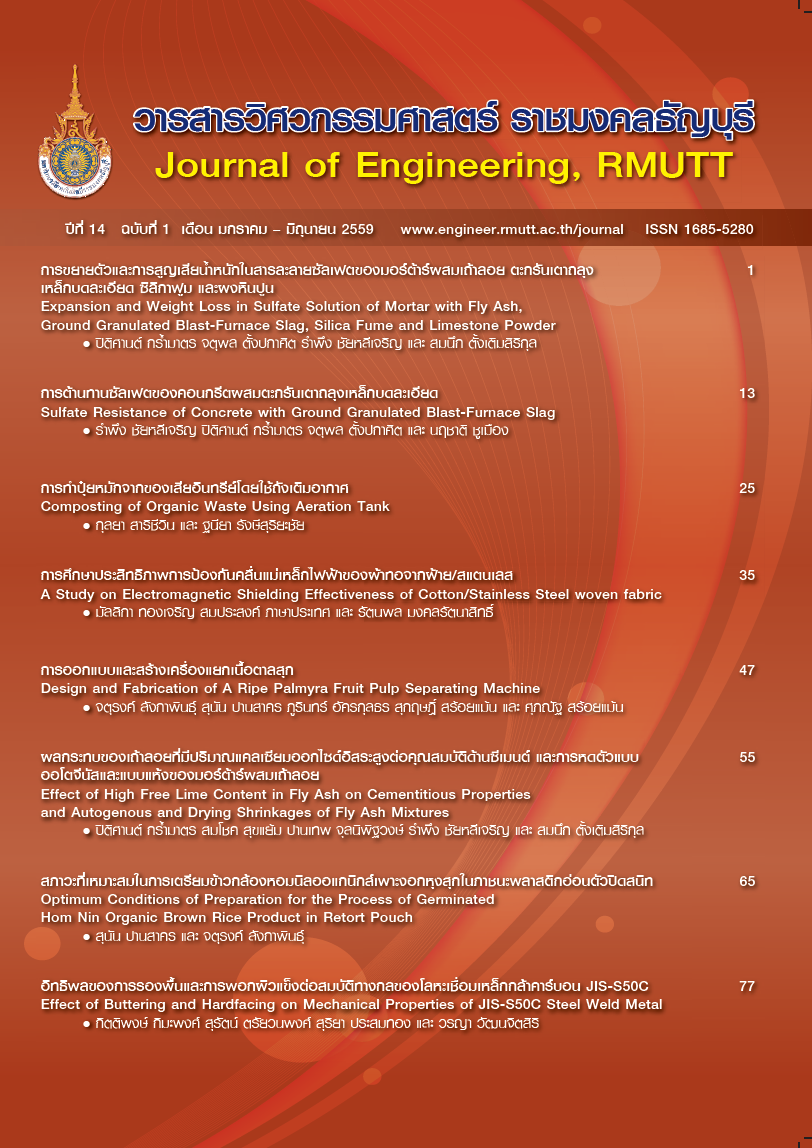Effect of Buttering and Hardfacing on Mechanical Properties of JIS-S50C Steel Weld Metal
Main Article Content
Abstract
This research aim is determined to study the effect of flux-cored arc welding parameters on the mechanical properties of JIS-S50C carbon steel hard-faced weld metal. This work is also studied a relation between mechanical properties and microstructure of hard-faced weld metal. The experimental results are summarized as follows. 1) Increasing the welding current is directly affected to increased hardness and wear resistance of a hard-faced weld metal. 2) Metallographic examinations of the hard faced weld at the top surface are showed the increased some elements which able to increase the hardness of weld metal i.e. silicon, vanadium, chromium, manganese and molybdenum. The increased hard-faced weld layer is affected for the hardness increasing and wear resistance of the weld metal because of their increased reinforced elements. Optimized welding parameters are produced for the maximum hardness of 837 HV which the minimum weight loss of 0.0218% i.e. that is not welded the first welded buffer layer, using the welding current of 210 A, the welding speed of 300 mm/min and the 3 hard-faced weld layers.
Article Details
The manuscript, information, content, picture and so forth which were published on Frontiers in engineering innovation research has been a copyright of this journal only. There is not allow anyone or any organize to duplicate all content or some document for unethical publication.
References
กิตติพงษ์ กิมะพงศ์, ศิริชัย ต่อสกุล, อนินท์ มีมนต์, นรพร กลั่นประชา, 2553. วัสดุวิศวกรรม. กรุงเทพมหานคร: เซนเกจ เลินนิ่ง (ประเทศไทย) จำกัด.
The James F. Linclon Foundation. Repair and Maintenance Procedures for Heavy Machinery Components. [ออนไลน์] เข้าถึงได้จาก: www.jflf.org (10 กันยายน 2558)
Selvi, S., Sankaran, S.P., Srivatsavan, R., 2008. "Comparative study of hardfacing of valve seat ring using MMAW process," Journal of Materials Processing Techno-logy, 207: 356-362.
Hemmati, I., Ocelík, V., De Hosson, J. T. M., 2012. "Dilution effects in laser cladding of Ni–Cr–B–Si–C hardfacing alloys," Materials Letters, 84: 69-42.
Yang, K., Yu, S., Li, Y., Li, C., 2008. "Effect of carbonitride precipitates on the abrasive wear behaviour of hardfacing alloy," Applied Surface Science, 254: 5023-5027.
Pedersen, W., Ramulu, M., 2006 "Facing SiCp/Mg metal matrix composites with carbide tools," Journal of Materials Pro-cessing Technology, 172: 417-423.
Ren, X.J., Yang, Q.X., James, R.D., Wang, L., 2004 "Cutting temperatures in hard turning chromium hardfacings with PCBN tooling," Journal of Materials Processing Technology, 147: 38-44.
Ren, X.J., James, R.D., Brookes, E.J., Wang, L., 2001. "Machining of high chromium hardfacing materials," Journal of Materials Processing Technology, 115: 423-429.
Buchely, M. F., Gutierrez, J. C., León, L. M., Toro, A., 2005. "The effect of micro-structure on abrasive wear of hardfacing alloys," Wear, 259: 52-61.
Chang, C.M., Chen, Y.C., Wu, W., 2010. "Microstructural and abrasive charac-teristics of high carbon Fe–Cr–C hardfacing alloy," Tribology International, 43: 929-934.
Buchanan, V.E., Shipway, P.H., McCart-ney, D.G., 2007. "Microstructure and abrasive wear behaviour of shielded metal arc welding hardfacings used in the sugar-cane industry," Wear, 263: 99-110.


